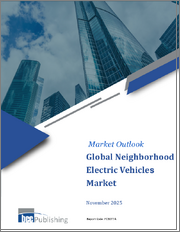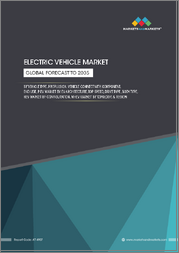
|
시장보고서
상품코드
1693635
중국의 전기자동차 시장 : 시장 점유율 분석, 산업 동향 및 통계, 성장 예측(2025-2030년)China Electric Car - Market Share Analysis, Industry Trends & Statistics, Growth Forecasts (2025 - 2030) |
||||||
중국의 전기자동차 시장 규모는 2025년에 6,200억 달러로 추정되고, 2029년에는 1조 1,200억 달러에 이를것으로 예측되며, 예측 기간 중(2025-2029년)의 CAGR은 15.99%를 나타낼 것으로 예측됩니다.

다양한 차량 구성에 초점을 맞추는 것은 광범위한 소비자 선호도를 충족시키며 전기차 혁신을 주도하려는 중국의 야망을 반영합니다.
- 중국의 활기찬 자동차 환경에서 전기차를 향한 움직임은 소비자 선호도의 광범위한 변화와 보다 지속 가능한 교통 생태계를 육성하려는 정책 방향을 반영하여 다양한 차량 부문에 걸쳐 시장 역학을 재편하고 있습니다. 해치백 HEV 부문은 소폭 감소할 것으로 예상되어 완전한 전기화를 향한 시장 조정을 예고하는 반면, 세단, SUV, MPV 부문은 친환경 수요, 기술 발전, 정부의 강력한 인센티브에 힘입어 지속적인 성장세를 보일 것으로 전망됩니다.
- 특히 세단 HEV 시장은 급격한 증가세를 보이고 있으며, 중국의 적극적인 탄소 감축 정책과 보조금 지급으로 인해 소비자들에게 HEV의 매력도가 더욱 높아질 것으로 예상됩니다. 마찬가지로 SUV HEV 부문도 기하급수적인 성장세를 보이며 환경적 이점과 SUV의 실용성 및 다목적성을 결합한 차량에 대한 선호가 뚜렷하게 드러났습니다. 이러한 추세는 계속될 것으로 예상되며, 하이브리드 기술의 지속적인 발전에 힘입어 10년 말까지 상당한 판매량을 기록할 것으로 예상됩니다.
- MPV 부문은 규모는 작지만 이러한 상승세를 반영하여 넓고 다재다능하며 친환경적인 운송 솔루션에 대한 중국 소비자의 다양한 요구를 보여줍니다. 충전 인프라 및 차량 기술의 발전과 함께 지속 가능한 교통수단을 장려하는 정부 정책이 이러한 성장을 촉진하는 핵심 요소입니다.
중국의 전기자동차 시장 동향
정부 노력과 강력한 OEM 투자로 중국 내 전기차 판매가 급격히 감소하고 있습니다.
- 차량 연료로 인한 가스 배출을 줄이기 위해 정부가 시작한 프로그램은 소비자들이 친환경 차량으로 전환하도록 장려하고 있습니다. 2020년 11월, 중국 정부는 2035년까지 화석 연료 차량을 금지한다고 발표하면서 신에너지 프로그램에 따라 100% 신에너지 차량을 판매할 것을 명시했습니다. 그 결과 전기자동차에 대한 수요가 증가했습니다. 이러한 규제 도입으로 최근 몇 년 동안 중국에서는 전기차와 이에 사용되는 다양한 부문의 배터리 팩의 판매가 증가했습니다.
- 중국 정부는 중국 내 전기자동차 수요를 촉진하고 향상시키기 위해 고객과 제조업체를 위한 다양한 제도와 인센티브를 도입하고 있습니다. 2022년 5월, 정부는 전기자동차 판매를 늘리기 위해 보조금 프로그램을 재도입한다고 발표했습니다. 또한 정부는 전기차를 선택하는 고객에게 미화 1,500달러의 보조금을 지급할 예정입니다.
- 전기자동차에 대한 수요가 증가함에 따라 OEM은 전기자동차 부문에서 개발 및 생산을 늘릴 계획을 세우고 있습니다. 2021년 제너럴 모터스는 2025년까지 전기 및 자율주행 차량에 대한 지출을 200억 달러로 늘릴 계획을 발표했습니다. 2023년까지 20개의 새로운 전기 모델을 출시할 예정이며 중국에서 연간 100만 대 이상의 전기차를 판매하는 것을 목표로 하고 있습니다.
중국의 전기자동차 산업 개요
중국의 전기자동차 시장은 적당히 통합되어 있으며 상위 5개 기업이 53.91%를 점유하고 있습니다. 이 시장의 주요 업체는 BYD Auto Co. Ltd., Chongqing Changan Automobile Company Limited, Tesla Inc., Volkswagen AG, Wuling Motors Holdings Limited(알파벳 순 정렬) 등이 있습니다.
기타 혜택
- 엑셀 형식 시장 예측(ME) 시트
- 3개월간의 애널리스트 지원
목차
제1장 주요 요약과 주요 조사 결과
제2장 보고서 제안
제3장 소개
- 조사의 전제조건과 시장 정의
- 조사 범위
- 조사 방법
제4장 주요 산업 동향
- 인구
- 1인당 GDP
- 차량 구매를 위한 소비자 지출(CVP)
- 인플레이션율
- 자동차 대출 금리
- 공유 차량 서비스
- 전기화의 영향
- EV 충전소
- 배터리 팩 가격
- Xev 신모델 발표
- 중고차 판매
- 연료 가격
- OEM 생산 통계
- 규제 프레임워크
- 밸류체인과 유통채널 분석
제5장 시장 세분화
- 차량 구성
- 승용차
- 해치백
- 다목적 차량
- 세단
- SUV
- 승용차
- 연료 카테고리
- BEV
- FCEV
- HEV
- PHEV
제6장 경쟁 구도
- 주요 전략적 움직임
- 시장 점유율 분석
- 기업 상황
- 기업 프로파일
- BYD Auto Co. Ltd.
- Chery Automobile Co. Ltd.
- Chongqing Changan Automobile Company Limited
- Gac Aion New Energy Automobile Co.Ltd
- Hozon New Energy Automobile Co. Ltd.
- Li Xiang(Li Auto Inc.)
- Nio(Anhui) Co. Ltd.
- Tesla Inc.
- Volkswagen AG
- Wuling Motors Holdings Limited
제7장 CEO에 대한 주요 전략적 질문
제8장 부록
- 세계 개요
- 개요
- Five Forces 분석 프레임워크
- 세계의 밸류체인 분석
- 시장 역학(DROs)
- 출처 및 참고문헌
- 도표 일람
- 주요 인사이트
- 데이터 팩
- 용어집
The China Electric Car Market size is estimated at 0.62 trillion USD in 2025, and is expected to reach 1.12 trillion USD by 2029, growing at a CAGR of 15.99% during the forecast period (2025-2029).

The focus on diverse vehicle configurations mirrors China's ambition to lead in electric car innovation, catering to a broad spectrum of consumer preferences
- In China's vibrant automotive landscape, the push toward EVs is reshaping the market dynamics across different vehicle segments, reflecting broader shifts in consumer preferences and policy directives aimed at fostering a more sustainable transportation ecosystem. While the hatchback HEV segment anticipates a slight decline, signaling a market adjustment toward full electrification, the sedan, SUV, and MPV segments are poised for continued growth, propelled by a combination of eco-friendly demand, technological advancements, and strong governmental incentives.
- The sedan HEV market, in particular, has experienced dramatic increases, with projections indicating further expansion, underscored by China's aggressive carbon reduction policies and subsidies that make HEVs more appealing to consumers. Similarly, the SUV HEV sector has shown exponential growth, highlighting a clear preference for vehicles that merge environmental benefits with the practicality and versatility of SUVs. This trend is expected to continue, with sales projected to reach significant numbers by the end of the decade, driven by ongoing advancements in hybrid technology.
- The MPV segment, while smaller, mirrors this upward trajectory, showcasing the diverse needs of Chinese consumers for spacious, versatile, and eco-friendly transportation solutions. Government policies promoting sustainable transportation, alongside developments in charging infrastructure and vehicle technology, are key factors fueling this growth. As China continues to navigate its path toward electrification, the varying trajectories of these vehicle segments reveal a complex and rapidly evolving market.
China Electric Car Market Trends
Government initiatives and strong OEM investments drive rapid drowth in electric vehicle sales in China
- The programs launched by the government to reduce gas emissions caused by vehicle fuels are encouraging consumers to shift to green vehicles. In November 2020, the government of China announced a ban on fossil fuel vehicles by 2035, clearly stating the selling of 100% new energy vehicles under the new energy program. As a result, the demand for electric cars increased. Adopting such regulations enhanced the sales of electric cars and various types of battery packs used in them in China in recent years.
- The government is introducing various schemes and incentives for customers and manufacturers to promote and enhance the demand for electric vehicles in the country. In May 2022, the government announced the reintroduction of the subsidy program to increase the sales of electric vehicles. Moreover, the government will allocate a subsidy of USD 1500 to customers opting for an electric car. Such factors have encouraged customers to invest in electric mobility, which further has increased the sales of electric cars by 2.90% in 2022 over 2021 in China.
- The growing demand for electric vehicles has forced OEMs to plan to increase development and production in the electric vehicle category. In 2021, General Motors announced its plans to raise its spending on electric and autonomous vehicles to USD 20 billion by 2025. The company is expected to launch 20 new electric models by 2023 and aims to sell more than 1 million electric cars a year in China. As a result, these factors are expected to drive the electric vehicle market in China during the 2024-2030 period.
China Electric Car Industry Overview
The China Electric Car Market is moderately consolidated, with the top five companies occupying 53.91%. The major players in this market are BYD Auto Co. Ltd., Chongqing Changan Automobile Company Limited, Tesla Inc., Volkswagen AG and Wuling Motors Holdings Limited (sorted alphabetically).
Additional Benefits:
- The market estimate (ME) sheet in Excel format
- 3 months of analyst support
TABLE OF CONTENTS
1 EXECUTIVE SUMMARY & KEY FINDINGS
2 REPORT OFFERS
3 INTRODUCTION
- 3.1 Study Assumptions & Market Definition
- 3.2 Scope of the Study
- 3.3 Research Methodology
4 KEY INDUSTRY TRENDS
- 4.1 Population
- 4.2 GDP Per Capita
- 4.3 Consumer Spending For Vehicle Purchase (cvp)
- 4.4 Inflation
- 4.5 Interest Rate For Auto Loans
- 4.6 Shared Rides
- 4.7 Impact Of Electrification
- 4.8 EV Charging Station
- 4.9 Battery Pack Price
- 4.10 New Xev Models Announced
- 4.11 Used Car Sales
- 4.12 Fuel Price
- 4.13 Oem-wise Production Statistics
- 4.14 Regulatory Framework
- 4.15 Value Chain & Distribution Channel Analysis
5 MARKET SEGMENTATION (includes market size in Value in USD and Volume, Forecasts up to 2029 and analysis of growth prospects)
- 5.1 Vehicle Configuration
- 5.1.1 Passenger Cars
- 5.1.1.1 Hatchback
- 5.1.1.2 Multi-purpose Vehicle
- 5.1.1.3 Sedan
- 5.1.1.4 Sports Utility Vehicle
- 5.1.1 Passenger Cars
- 5.2 Fuel Category
- 5.2.1 BEV
- 5.2.2 FCEV
- 5.2.3 HEV
- 5.2.4 PHEV
6 COMPETITIVE LANDSCAPE
- 6.1 Key Strategic Moves
- 6.2 Market Share Analysis
- 6.3 Company Landscape
- 6.4 Company Profiles
- 6.4.1 BYD Auto Co. Ltd.
- 6.4.2 Chery Automobile Co. Ltd.
- 6.4.3 Chongqing Changan Automobile Company Limited
- 6.4.4 Gac Aion New Energy Automobile Co.Ltd
- 6.4.5 Hozon New Energy Automobile Co. Ltd.
- 6.4.6 Li Xiang (Li Auto Inc.)
- 6.4.7 Nio (Anhui) Co. Ltd.
- 6.4.8 Tesla Inc.
- 6.4.9 Volkswagen AG
- 6.4.10 Wuling Motors Holdings Limited
7 KEY STRATEGIC QUESTIONS FOR VEHICLES CEOS
8 APPENDIX
- 8.1 Global Overview
- 8.1.1 Overview
- 8.1.2 Porter's Five Forces Framework
- 8.1.3 Global Value Chain Analysis
- 8.1.4 Market Dynamics (DROs)
- 8.2 Sources & References
- 8.3 List of Tables & Figures
- 8.4 Primary Insights
- 8.5 Data Pack
- 8.6 Glossary of Terms



















